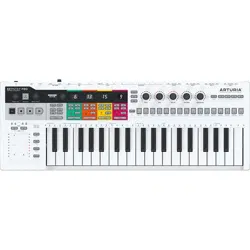Loading ...
Loading ...
Loading ...

8.2.3. Controlling Parameters in a DAW
With CC# messages you can also control parameters of plugins, including virtual
instruments, loaded in your DAW. All plugins of the Arturia V Collection series have a MIDI
learn feature that enables you to link knobs on the KeyStep Pro front panel to knobs in the
plugin. Imagine all the new sonic options you have when using the KeyStep Pro's encoders
to simultaneously control the filters of the CZ V, the DX7 V and the Buchla Easel V, for
example.
Please refer to the documentation that comes with your DAW and the V Collection for
detailed descriptions of how to do this.
♪: CC# messages transmitted over MIDI can also be used to control parameters on a modular
system, but to make that possible you need a module capable of converting CC# values to analog
voltages.
The controller assignments can be set in Utility>Controller and the MIDI Control Center
[p.155].
8.2.4. More about CC# Patterns
The CC# values can be sequenced as we've seen above. However, they can also be used in
a more general way to set parameters in an external synth. If you send a certain CC# value
in the first step of a Pattern and there are no other values programmed in that Pattern, this
initial value will be held during the sequence. This feature gives you the creative option of
sending a new configuration to the external synth, module or virtual instrument at the start
of each Pattern!
!: Patterns can be chained. CC# Patterns are no exception. If you have three similar Patterns chained,
you can store CC# values in the first step of each Pattern. For example, in the first Pattern, you store a
CC# value for a half-open filter; in the second Pattern you store a CC# value that opens the filter a bit
further; in the third Pattern you store a CC# value that fully opens the filter.
If you use the steps of Patterns to send different CC# values in each step, there is a feature
you can use to great effect: the looper, the horizontal control strip located under the two
vertical touch strips. The looper also works in Control mode. If you loop part of a sequence,
you will also loop the CC# values in that part of the sequence.
♪: There is one important difference between a normal track and a track in Control mode: a normal
track can be muted, but a control track cannot. It will always transmit CC# messages as long as it is
playing.
142 Arturia - User Manual Keystep Pro - Control Mode
Loading ...
Loading ...
Loading ...
